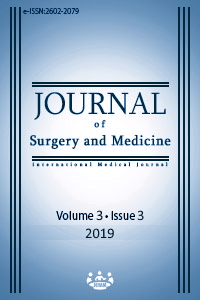Evaluation of self-care agency of patients with diabetic foot infection: A cross-sectional descriptive study
Keywords:
Diabetes, Diabetic foot infection, Self-care agencyAbstract
Aim: Diabetes mellitus is a chronic disease and causes a major complication such as diabetic foot infection. Accordingly, we think that the mobilization of patients will decrease and self-care will decrease. The aim of this study was to evaluate the self-care agency of patients with diabetic foot infection.
Methods: This is a questionnaire-based cross-sectional study to identify the self-care agency of 97 patients with diabetic foot infection. Data were collected by face to face interview technique, using a questionnaire the Self-care Agency Scale which is consists of a total of 35 questions.
Results: When the self-care agency of the participants was evaluated, it was observed that 30.9% (n = 30) of the cases were low, 58.8% (n = 57) were moderate, and 10.3% (n = 10) were high. There was a statistically significant positive correlation between amputation time and self-care agency total score (r = 0.514, p = 0.002).
Conclusion: As a result, diabetes and its complications are an important group of diseases that we frequently encounter. We think that self-care will be better with education to be given to patients and their relatives.
Downloads
References
http://www.who.int/mediacentre/factsheets/fs138/en/ Last access date 21.10.2018.
Yılmaz C. Giriş. Yılmaz C, editor. Diyabet Hemşiresi El Kitabı. İzmir: Asya Tıp Yayıncılık; 2002. 1-12.
Elkin M. Laboratory Tests. In Elkin ME, Perry AG, Potter PA, editors. Nursing Interventions & Clinical Skills. 3th Edition. United States of America: Mosby, An Affiliate of Elsevier Science; 2004. p. 360-5.
Smeltzer SC, Bare B. Brunner & Suddarth’s Textbook of Medical Surgical Nursing. 10th Edition, Philadelphia: Lippincott Williams &Wilkins A Wolters Kluwer Company; 2004. p.1149-203.
Masharani U, Karam JH. Diabetes Mellitus & Hypoglycemia. In Tierney LM, McPhee SJ, Papadakis MA, editors. Current Medical Diagnosis & Treatment. Adult Ambulatory & Inpatient Management. Fort-First Edition, NewYork: McGrow Hill Companies; 2002. p. 1203-38.
Fadıloğlu Ç. Diyabetin yönetimi ve hemşirelik. İçinde Yılmaz C, editor. Diyabet Hemşiresi El Kitabı. İzmir: Asya Tıp Yayıncılık; 2002. p. 74-120.
Balcı G. Özbakım gücü ve yaşam kalitesinin etkilendiği bazı durumlar ve hemşirenin rolü. Hacettepe Üniversitesi Hemşirelik Yüksekokulu Dergisi. 2003;10(2):69-76.
Catharine H, Johnston B, Lewis MA, Garg S. Self Efficacy impacts self-care and HbA1c in young adults with type 1 diabetes. Psychosomatic Medicine. 2002;64:43-51.
Toljama M, Hentinen M. Adherence to self-care and glycaemic control among people with insülin-dependent diabetes mellitus. Journal of Advanced Nursing. 2001;34(6):780-6.
Van den Arend IJM, Stolk RP, Ruttent GEHM, Schrijvers GJP. Education integrated into structured general practice care for type 2 diabetic patients results in sustained improvement of disease knowledge and self –care. British Diabetic Association. Diabetic Medicine. 2000;17:190-7.
Hosley JB, Molle-Mathews EA. Lippincott’s Textbook for Clinical Medical Assisting. Philadelphia: Wolter Kluwer Company; 1999. p. 320-34.
Kearney BY, Fleischer BJ. Development of an instrument to measure exercise of self-care agency. Res Nurs Health. 1979;2:25-34.
Nahçivan NÖ. Turkish Language Equivalence of the Exercise of Self- Care Agency Scale. Western Journal of Nursing Research. 2004;26(7):813-24.
Pınar R. A new aspect of health-related research: quality of life, evaluation of reliability and validity of a quality of life survey in patients with chronic diseases. Hemşirelik Bülteni. 1995;9:85–95.
Yılmaz SD, Beji NK. Gebelikte öz bakım gücünün değerlendirilmesi. Genel Tıp Derg. 2010;20(4):137-42.
Kanatlı U. Diyabetik ayak enfeksiyonları. TOTBİD Dergisi. 2011;10(4):296-305.
Mohammadpour A, RahmatiSharghi N, Khosravan S, Alami A, Akhond M. The effect of a supportive educational intervention developed based on the Orem's self-care theory on the self-care ability of patients with myocardial infarction: a randomised controlled trial. J Clin Nurs. 2015;24(11-12):1686-92.
Bozkurt F, Tekin R, Çelen MK, Ayaz C. Diyabetik Ayak İnfeksiyonlarında Tedavi Yaklaşımı. Konuralp Tıp Dergisi. 2012;4(2):15-9.
Şenoğlu S, Karabela ŞN, Yaşar KK, Durdu B, Gedik H, Ersöz B, et al. Diyabetik Ayak Enfeksiyonlu Yirmi Yedi Olgunun Retrospektif Olarak Değerlendirilmesi. Med Bull Haseki. 2017;55:56-60.
Altay B, Avcı İA. Huzurevinde yaşayan yaşlılarda özbakım gücü ve yaşam doyumu arasındaki ilişki. Dicle Med J. 2009;36(4):275-82.
Nazik H, Gül FÇ, Gül FC, Nazik S, Okay RA, Mülayim MK, et al. Evaluation Of Self-Care Power In Leprosy Patients. Kocaeli Med J. 2018;7(1):77-82.
Karakurt P, Aşılar RH, Yıldırım A. Diyabetli hastaların öz bakım gücü ve algıladıkları sosyal desteğin değerlendirilmesi. ADÜ Tıp Fakültesi Dergisi. 2013;14(1):1–9.
Özçakar N, Mehtap KM, Kuruoğlu E. Diyabet hastalarının özbakım bilinci. Türk Aile Hek Derg. 2009;13(1):17-22.
Muz G, Eğlence R. Hemodiyaliz Uygulanan Hastalarda Öz Bakım Gücü ve Öz Yeterliliğin Değerlendirilmesi. Balikesir Saglik Bil Derg. 2013;2 (1):15-21.
Downloads
- 1361 2120
Published
Issue
Section
How to Cite
License
Copyright (c) 2019 Selçuk Nazik, Hülya Nazik, Ahmet Rıza Şahin, Selma Ateş
This work is licensed under a Creative Commons Attribution-NonCommercial-NoDerivatives 4.0 International License.
















